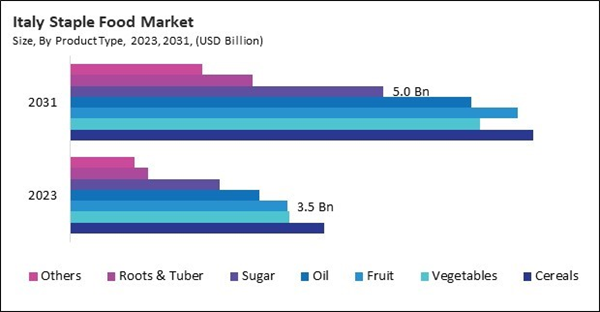The Germany market dominated the Europe Staple Food Market by Country in 2023, and is forecast to continue being a dominant market till 2031; thereby, achieving a market value of $154.36 billion by 2031. The UK market is exhibiting a CAGR of 5.8% during (2024 - 2031). Additionally, The France market is projected to experience a CAGR of 7.9% during (2024 - 2031).
Staple foods are essential to livestock diets, providing feed for poultry, cattle, pigs, and other livestock. Grains like maize and wheat and tubers such as potatoes serve as valuable energy sources and nutrients for animal growth and production. The demand for animal feed from essential foods supports integrated farming systems and contributes to the livestock industry’s sustainability.
Adoption and consumption patterns of essential foods vary significantly across regions and are influenced by a complex interplay of factors, including geography, climate, culture, economic development, and dietary preferences. Consumption patterns reflect traditional culinary practices and nutritional needs, with essential foods forming the basis of hearty, carbohydrate-rich meals.
Europe’s agricultural output, including essential foods, contributes significantly to global food trade. The EU is a major exporter of agricultural products, influencing global market dynamics and trade flows for staples like wheat, dairy products, and processed foods. As per the Climate Scorecard, the EU traditionally exports more agricultural products than imports; in 2020, agriculture comprised 9.5% of the EU’s total exports and 7.1% of the EU’s total imports. In 2021, agriculture made up 1.3% of the EU’s GDP. France makes the largest agricultural contribution within the EU, followed by Italy and Spain. Furtehrmore, the growth of the agri-food industry in the UK contributes to increased domestic production of essential foods such as wheat, barley, oats, potatoes, and vegetables. As per the Government of the United Kingdom, the agri-food sector contributed £128.3 billion or 6.3% to the national gross value added in 2021. In conclusion, the agri-food industry's expansion and the region's increasing agriculture sector are driving the market's growth.
List of Key Companies Profiled
- Cargill, Incorporated
- Danone S.A.
- JBS S.A.
- Archer Daniels Midland Company
- The Kraft Heinz Company
- Kellogg Company
- General Mills, Inc.
- Unilever PLC
- Arla Foods amba
Market Report Segmentation
By Nature- Conventional
- Organic
- Cereals
- Vegetables
- Fruit
- Oil
- Sugar
- Roots & Tuber
- Others
- Wholesale Distributors
- Direct-to-Consumer (D2C)
- Retail Stores
- Online Retailers
- Others
- Germany
- UK
- France
- Russia
- Spain
- Italy
- Rest of Europe
Table of Contents
Companies Mentioned
- Cargill, Incorporated
- Danone S.A.
- JBS S.A.
- Archer Daniels Midland Company
- The Kraft Heinz Company
- Kellogg Company
- General Mills, Inc.
- Unilever PLC
- Arla Foods amba









